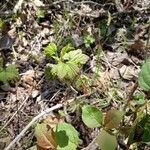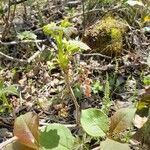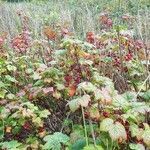Shrubs low, almost creeping, to 0.4 m tall, rarely erect to 0.8 m tall. Branchlets spreading, glabrous or puberulent when young, unarmed. Buds brown, ovoid, 4-6 mm, sparsely pubescent, apex acute. Petiole (1.5-)3-6 cm, puberulent, scattered stalked glandular; leaf blade reniform to orbicular-reniform, 3-6 × 4-7(-8) cm, glabrous or pubescent along veins abaxially, base shallowly cordate or subtruncate; lobes 3(-5), broadly triangular, margin coarsely sharply serrate, apex obtuse; terminal lobe slightly longer than lateral ones. Racemes pendent, lax, 2-4 cm, (3-)5-7-flowered; rachis and pedicels pubescent and sparsely glandular hairy; bracts ovate-orbicular, rarely oblong, 1.5-2 mm. Flowers bisexual; pedicel 2.5-4 mm. Calyx purple, glabrous; tube shallowly cupular to subpelviform; lobes erect, purple or red tinged yellowish green, spatulate-orbicular, 1.5-2.5 mm. Petals red or purple, subflabellate to obovate or square, sometimes subcuneate, 0.7-1.3 mm. Stamens subequaling petals. Ovary glabrous. Style stout, subequaling stamens, deeply divided for ca. 1/2 its length or more. Fruit red, ovoid, 0.7-1 cm in diam., glabrous. Fl. May-Jun, fr. Jun-Aug.
Unarmed straggling shrub; lvs glabrous to softly hairy beneath, broadly truncate to shallowly cordate at base, mostly 5-lobed, the lobes toothed from sinus to tip, the two middle sinuses the deepest, the lateral lobes direct forward; racemes drooping, the axis and pedicels (1–4 mm) often with short-stipitate glands; hypanthium above the ovary saucer-shaped, less than 1 mm; sep greenish-purple, broadly rhombic-ovate, 2 mm; pet cuneate, 1 mm, truncate or notched; fr red; 2n=16. Bogs and wet woods; Nf. to Alas., s. to N.J., Mich., Wis., Minn., and Alta.; n. Asia. June, July.
A shrub. It does not have thorns. It grows 1.5 m tall. The leaves turn bright red then yellow before falling off in autumn. The flowers are reddish or dull purple. They are small and 6-15 occur in drooping clusters. The flower stalks have joints. The fruit are bright red and sour.



